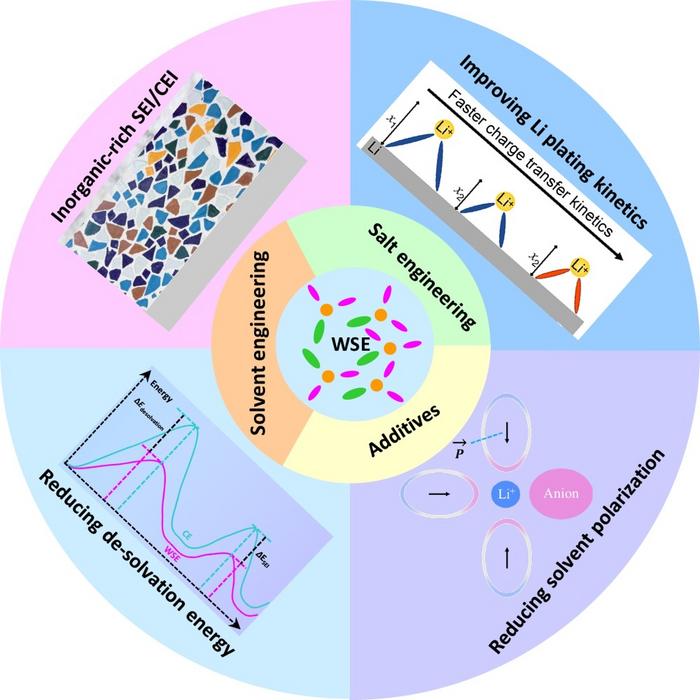Lithium batteries power our phones, computers, many of our cars and so much more — even the drill and weedwhacker. But as technology advances, can they keep up in their current format? No, but there is a way forward, according to a new review paper from researchers at Hong Kong Polytechnic University, by further developing the electrolytes that allow for energy storage and discharge.

Credit: Energy Materials and Devices, Tsinghua University
Lithium batteries power our phones, computers, many of our cars and so much more — even the drill and weedwhacker. But as technology advances, can they keep up in their current format? No, but there is a way forward, according to a new review paper from researchers at Hong Kong Polytechnic University, by further developing the electrolytes that allow for energy storage and discharge.
The team published their work in Energy Materials and Devices on September 18, 2023.
“Lithium batteries have revolutionized our modern life,” said first author Zhijie Wang, a Postdoctoral Research Fellow in the Department of Applied Physics and the Research Institute of Smart Energy at Hong Kong Polytechnic University. “The performance of lithium batteries — including energy density, lifespan, safety and more — is greatly determined by the recipe and microstructure of the electrolytes.”
Lithium batteries consist primarily of two current collectors, a negatively charged electrode, a positively charged electrode, an electrolyte and a separator. The electrolyte carries positively charged lithium ions from the positively charged electrode through the separator to the other electrode and negatively charged ions in the other direction. As the lithium ions move through the electrolyte, the anode collects free electrons, leading to a positive charge at one current collector. That positive current discharges to power a device, flowing through and returning to the battery as a negative current.
Electrolytes most commonly comprise a solution of lithium salt in a polar solvent, or a substance that uses a tiny electrical charge produced by the shape of its constituent molecules to dissolve the salts and free the lithium ions. In conventional electrolyte, lithium ions separate with the salt anions; in the (localized) high-concentration electrolytes developed in recent years, salt anions are solvated with Li ions, and they have unique functions in improving battery performance.
However, Wang said, a type called weakly solvating electrolytes first proposed for this use three years ago may offer a pathway to more robust batteries. In this type of electrolyte, the lithium ions are weakly coordinated with the solvent molecules, and they also coordinate with the negatively charged salt anions.
“Such a structure can be obtained in a relatively dilute salt concentration and without the use of non-solvating diluters,” Wang said. “This makes it different from conventional electrolytes and (localized) high-concentration electrolytes. It can improve the low-temperature, fast-charging, safety and cycling properties of lithium batteries, so it has attracted intensive research interest in recent years.”
In this study, Wang and corresponding author Biao Zhang examined recent research papers on weakly solvating electrolytes and concluded that basic design principles and future research directions were lacking. Zhang is an associate professor in the Department of Applied Physics and the Research Institute of Smart Energy at Hong Kong Polytechnic University.
“We found, from the current literature, that the key to constructing weakly solvating electrolytes is creating a balance between the interactions of lithium ions with solvent and anions,” Wang said. “We also determined that the design concepts of weakly solvating electrolytes can be extended to other batteries, such as systems made with sodium, potassium, magnesium or zinc.”
The researchers also recommended that future work in the field should focus on simplifying the synthesis procedures, improving yields and reducing costs of the electrolyte components.
“The goal of this paper is to promote the understanding of both research and industrial communities on the functions, design principles and recent research progress of the emerging weakly solvating electrolytes,” Wang said. “We hope our insights contribute to developing next-generation lithium batteries with robust properties and thus boost their share of the power source market, especially in electric vehicles.”
The Hong Kong Polytechnic University supported this work.
##
About Energy Materials and Devices
Energy Materials and Devices is launched by Tsinghua University, published quarterly by Tsinghua University Press, aiming at being an international, single-blind peer-reviewed, open-access and interdisciplinary journal in the cutting-edge field of energy materials and devices. It focuses on the innovation research of the whole chain of basic research, technological innovation, achievement transformation and industrialization in the field of energy materials and devices, and publishes original, leading and forward-looking research results, including but not limited to the materials design, synthesis, integration, assembly and characterization of devices for energy storage and conversion etc.
About SciOpen
SciOpen is a professional open access resource for discovery of scientific and technical content published by the Tsinghua University Press and its publishing partners, providing the scholarly publishing community with innovative technology and market-leading capabilities. SciOpen provides end-to-end services across manuscript submission, peer review, content hosting, analytics, and identity management and expert advice to ensure each journal’s development by offering a range of options across all functions as Journal Layout, Production Services, Editorial Services, Marketing and Promotions, Online Functionality, etc. By digitalizing the publishing process, SciOpen widens the reach, deepens the impact, and accelerates the exchange of ideas.
Journal
Energy Materials and Devices
DOI
10.26599/EMD.2023.9370003
Article Title
Weakly solvating electrolytes for next-generation lithium batteries: design principles and recent advances
Article Publication Date
18-Sep-2023




